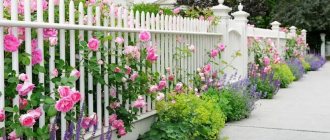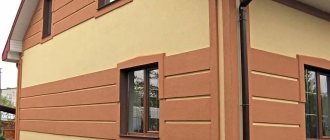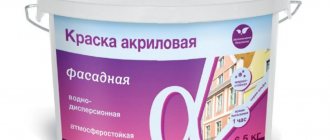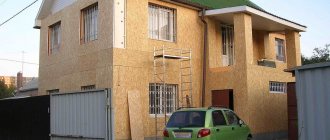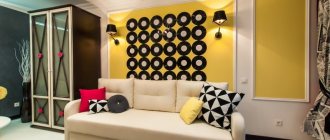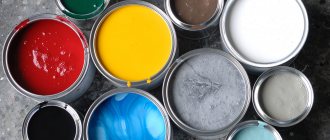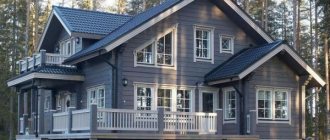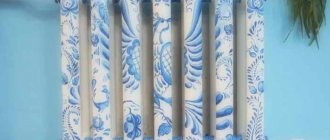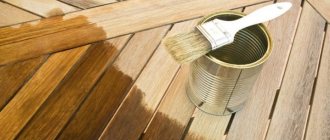About the general principles of color selection
House designs presented on numerous construction sites are in most cases made in neutral shades. This is done so that the colors do not distract from the details of the project, allowing you to more fully appreciate the design. The choice of colors for the facade and roof goes to the owner; it will be successful if you follow the simple rules that guide professional designers.
Before settling on a particular color scheme, you should decide whether you want to highlight your home, emphasizing its advantages, or, conversely, make it invisible, built into the environment. The solution to this question will tell you which direction to move in. The first option will require rich colors and bold combinations, while the second will require a harmony of natural shades.
For fans of extravagant solutions Source indeco.ru
When choosing colors for a country house, it is important to remember some features that are inherent in all colors, albeit to varying degrees. All of them have the following properties:
- Burnout . The more saturated and bright the color, the more noticeable it is. The champion in terms of burnout speed is black; brown, red and lilac roofing will be exposed to the sun to a lesser extent. The best durability is demonstrated by the gray color, which only slightly changes the shade. A white roof is also not ideal; elegant at first, over time it will inevitably turn yellow, and not evenly, but in spots.
- Heat absorption . We remember from a school physics course: the lighter the surface, the more it reflects light, and the darker the coating, the more it absorbs solar energy. Therefore, the further north the house is located, the more practical the choice of dark materials and colors for its facade and roof becomes.
Bright colors become lighter over time Source houzz.com
- Accentuation . Paints can change the external impression of a building. Light shades visually enlarge the object, dark shades make it smaller, but also give clarity to the details. Caution is needed when using several bright colors - this is usually a good solution for a house of a simple shape with a minimum of architectural details.
To simplify the task, it is convenient to approach the selection of a suitable color scheme in one of the following ways:
- Choice of shades of the same color . A common and almost win-win option. One color is divided into successive shades: for the roof, facade walls and smaller details. Buildings made in green, sand or brown tones look harmonious; more boldly - in red or blue.
Choosing shades of the same color Source dvamolotka.ru
- Choice of contrasting colors . The appearance of such a building will be bright and memorable. The color scheme is based on two maximum contrasting colors, for example, chocolate brown for the roof material and pale yellow or beige for the facade. Sometimes, to enhance the effect, facade details (doors, trim, plinth) are also painted to match the roof.
Selection of contrasting shades Source iteragroup.com.ua
- Combination with white color . A universal option, given that white harmonizes perfectly with both pale and rich shades.
The combination with white is also contrasting Source rooftrend.com.ua
- Combinations of several colors . A three-color combination is specified: brown – beige – olive or gray – pink – white. They are complemented by a suitable secondary tone, which is supposed to be used for finishing. With the right selection, even a black facade of a house, complemented by a light roof, will look harmonious and stylish.
Combination of several colors Source krona-yug.ru
General progress of painting the wooden facade
Painting a wooden house from the outside conventionally occurs in two main stages: preparing the wooden surface for applying paint and varnish and directly applying the paint and varnish coating.
Surface preparation
This is an important point in determining how to paint a wooden house with maximum protective effect. Applying paint to an unprepared wooden surface is extremely undesirable, since conditions for good adhesion of paintwork materials will not be provided and the rules for treating wood against negative biological influences will not be followed. Preparing the surface for painting involves the following activities:
- if the building is new, then it is enough to clean the wooden surface from dust and dirt using any available means.
- if it is necessary to paint the facade of an old building, then first remove the remnants of the old paintwork and destroy traces of mold;
Old paint is removed as thoroughly as possibleSource purpleclover.com
- damaged areas of the wooden surface are repaired, all irregularities are smoothed out, cracks are puttied;
- nail heads and metal inclusions are coated with a metal primer;
- It is advisable to carry out final leveling with a primer.
Applying paint and varnish to the prepared façade surface
It is carried out in the following sequence:
- the wood is impregnated with a primer antiseptic in order to enhance its protective qualities and improve its adhesive ability;
- a finishing coat is applied, consisting of a layer of wood primer and several layers of paint, with a time interval to ensure complete drying of each previous layer.
Painting the new and old surfaces is carried out in the same sequence, but several nuances should be taken into account:
- the façade surface of the old building must be painted with the same type of paint and varnish that was originally applied;
- When painting old wood, the use of a roller is not recommended, since microcavities are formed in its structure due to cyclic swelling and shrinkage, which the paint from the roller does not fill. It's better to use a brush.
The process of painting a house is clearly shown in the video:
Methods for choosing the color of the roof and facade
White facades have not been in fashion for a long time. They have been replaced by more interesting color solutions that are pleasing to the eye and less dirty. This approach to decorating the house entailed the need to install a colored roof, preferably in harmony with the shade of the walls and fitting into the surrounding environment.
Bright facade of a private house with a colored roof
Before you start painting and purchasing roofing materials, try to visualize the color concept you like. An architectural bureau or design studio will help you do this. You can, of course, try to draw an approximate picture with watercolors or crayons, but in the electronic version the colors will look much closer to real ones, and the house itself on the monitor screen will be displayed in a three-dimensional image, so you can view it from all angles, and if you wish, also on background of the surrounding landscape.
Visualization of the color concept of the house facade
Not everyone can afford to order a house and roof color design project. This is not a disaster, because you can decide on the shade range of their decor in another way, for example, by creating templates. The flat projection of the facade is transferred to transparent tracing paper or film. The roof model is cut out separately. Now all that remains is to apply elements to the color layout from manufacturers of paint, roofing materials, etc. and combine them into a single whole. In this way, you can quickly review a lot of combinations, putting aside the most interesting ones in your opinion.
Model of a house for selecting facade and roof color options
Very good sample in nature. Many factors can influence how the color on the roof and facade behaves. The most significant of them are:
1. Type of lighting.
2. The texture of the surface itself.
Options for the texture of the facade of a private house
Do not rush to purchase material for the entire scope of finishing work at once. Try to initially paint or plaster a small section of the facade, up to a square meter. The shade is assessed under a variety of lighting conditions:
- in the morning, at sunrise;
- during the day;
- in the evening, by the light of lanterns;
- in cloudy weather.
The disadvantage of this selection method is that only a very limited number of colors can be tested.
To judge the color, paint a small section of the wall first.
Painting the house outside
paint the outside of your house yourself
by following these recommendations:
- The work of painting the facade must be planned by checking the weather forecast. On rainy, windy days or at temperatures below +5 ° C, it is better not to paint the facade.
- The surfaces to be painted must first be primed
. To apply primer to the wall, use the same methods as for applying paint (see above). - Before starting work, all non-painted parts of the facade (windows, doors, slopes, plinth, blind area, etc.) are protected with plastic film.
- Painting work is carried out in dry weather in the absence of strong wind. The outside air temperature must be within the operating range indicated on the exterior paint packaging. Check the weather forecast before starting work.
- To paint the facade at a height, install scaffolding or scaffolding. Painting the facade from the stairs is inconvenient and dangerous.
- A layer of paint is applied to one wall of the house without taking long breaks in work. If you paint part of the wall the next day, there will be streaks on the wall - places with different shades of paint.
- The second layer of paint is applied after a certain break, not earlier than indicated by the manufacturer on the paint packaging.
- In order not to wash the roller or brush before each break in work, wrap the tool in a plastic bag - the paint will not dry out.
The paint is distributed by moving the roller or brush in different directions alternately - vertically, horizontally and diagonally.
Color combination techniques
The facade of the house can be divided into:
- walls,
- plinth,
- roof,
- additional elements: corners, window and door openings, soffits, gutters, etc.
As a rule, the base and roof are made of one shade, the walls of another. The corners can be the same color as the base or wall, or contrasting (most often white). In the first case, the house will look smaller and neater, in the second - more spacious. Openings, soffits and gutters can be made in a contrasting shade or to match the base.
Designers use different techniques to change the visual perception of a building. Consider them when choosing siding, colors, combinations.
1. Light colors make space appear larger.
Siding in light, pastel shades is good for small buildings to give them volume. It will look advantageous against the backdrop of dark treetops or fences.
!
Light siding gives small buildings volume and makes them visually more spacious.
2. Dark shades make the house visually smaller.
This finish is suitable for large cottages that want to give a strict look. In addition, dark colors will help the house “get lost” among the trees.
3. Bright colors give your home a fresh look.
This is a bold and interesting solution, but you should not use more than one bright color on the facade. The corners can be emphasized with a contrasting shade, which certainly matches the main one.
4. Contrast is used for buildings with complex architectural forms.
The walls are made in one color, and all protruding elements are made in another. Moreover, if the second one is lighter, the facade will look lighter and more elegant.
How to highlight architectural elements of a building with color (photo No. 2)
5. Buildings of simple shape are a field for design experiments.
Here you can combine different shapes and colors to create a spectacular look. But they must be in harmony with each other.
Colored details change a simple facade (photo No. 3)
6. Dark bottom, light top.
Classic combination: dark base and light walls. The color of the base can (but not necessarily) be matched to the roof and reinforced with corner elements, finishing of window and door openings.
Classic combination (photo No. 4)
7. Inversion
Inversion in facade decoration (photo No. 5)
A bold decision that not every homeowner dares to make: a light base and dark walls.
Priming the walls of the house outside
The primer allows you to:
- strengthen the dusty base;
- increase the adhesion (adhesion) of paint to the base;
- reduce water absorption of the coating;
- reduce the consumption of facade paint.
Facade paint spreads more easily over a primed surface, and its consumption is noticeably reduced
.
It is best to use a primer recommended by the façade paint manufacturer.
chosen to paint the exterior of the house.
The quality of painting the facade of a house can be improved if the primer is tinted to match
, close to the color of the façade paint.
Facade paint diluted with water is sometimes used as a primer.
in a 1:1 ratio.
The primer is applied to the wall surface in the same way as paint. Before painting, the primer must be allowed to dry completely for at least 24 hours.
How to choose the color of the facade
Home ownership is a territory of comfort; nothing here should cause discomfort. Everyone has their own color preferences and understanding of how to choose the color of the facade of a private building.
Important! Color affects your sense of self, mood and even health.
Even the recommendations of the most authoritative experts should not influence the choice if you initially don’t like something. For example, if the color black or dark green causes internal rejection.
The fashion for certain color preferences will pass, but you will live in this house for many years.
Painting a brick house
Brick houses are distinguished by their fundamental nature and durability. Most often, brickwork is used to create a decorative appearance for the building. If there is a need to paint a brick wall, then the choice should be guided by personal preferences and structural features.
For brickwork it is not necessary to use natural shades, as, for example, for wood. You can choose any colors, but remember that light colors are most suitable for large and simple modern structures.
The style of the building determines the color: in the Baroque style, it is preferable to paint brick buildings in brown and terracotta colors, for Gothic - gray and dark shades. It is recommended to use light colors to design openings and protruding elements.
The influence of tradition and landscape on the choice of flowers
Most often, the selection of color combinations for the facade and roof takes into account the location, features of the local landscape and national traditions:
- In hot southern regions, cool shades are popular, from white and lilac to emerald and bright blue.
- In regions with cold and long winters, warm colors are popular: yellow, chocolate, red, orange.
- In lowland forest regions, facades and roofs in natural shades are common - earth, grass, moss, sand.
- In flat steppe regions, bright finishing materials are used to decorate the roof: red, cherry or orange.
A warm option for a cold winter Source doka-metal.ru
- Near a lake , river or on the sea coast, a combination of white, turquoise, blue and light blue is popular.
- Country cottages look especially attractive in pastel colors.
- If the estate is surrounded by an extensive garden , its design can include a bright palette with yellow, purple and lavender accents.
- Private house in a residential area . Modern urban architecture involves experimenting with bright and unexpected color combinations.
- Building in the old quarter . You will have to adapt to the style of the environment so as not to destroy the historical surroundings.
Facade in a pastel palette Source doka-metal.ru
Benefits of use
First, let’s try to figure out what is hidden behind this undeniably noticeable trend: the indirect influence of dualism, practicality, or convenient integration into any design concept. Let's take a look at the obvious advantages of two-tone painting of walls in an apartment:
- zoning of the room
- using this painting method, you can organically divide the room into functional zones, and do this with a minimum of material and time costs; - correction of visual perception
- a skillfully selected combination in a pair can help you visually make the room taller or wider, depending on the specific goal; - the principle of contrast
- without light there is no darkness, and in painting one of the shades serves as a natural complement to the other to create an impressive harmonious design of the walls; - color balance
– some shades seem boring and urgently require addition, so the use of a gradient tone can enliven the interior and highlight some remarkable “features” in the design; - strong expressiveness
- skillful management of color pairs helps to correctly place accents in the design of an apartment using painting, muffle an undesirable effect and, conversely, bring the desired motives to the fore.
What is the advantage of a light facade?
It is better to take a lighter tone after construction, and then change something later, choosing more saturated tones from the same palette. A base that is too dark is difficult to paint over later.
If you want a light gray façade, it will be difficult to transform a brown or blue building. You will have to cover it with several layers of your preferred color.
If this is an old country building that does not have high aesthetics, you should not visually highlight it; it is enough to update the old whitewash or paint.
Painting walls in two colors: working recommendations
Combined painting requires planning and preparatory work. First of all, you will have to puzzle yourself with the selection of harmoniously combined tones. This is possible only after you decide for yourself what kind of result you want to get:
1. Contrast effect.
2. Ombre effect.
In the first case, you will need bright colors that are noticeably different from each other, possibly diametrically opposite in spectrum. If this is your first time deciding to paint walls with two colors, use a combination of shades that are similar in intensity and color scheme.
Contrast effect
In the second option, you will need to connect consonant tones that can smoothly replace each other. It would look so good to paint the walls in two neutral colors, say gray and cream. You can choose a combination of pastel colors, combining peach with sand or turquoise with delicate mint.
Ombre painting
You should always take paint with a reserve, since it will be extremely difficult to choose an absolutely identical shade. In fact, this will only become possible if the required tone was given to the composition automatically in a specialized store. If you are going to mix colors for painting walls in two colors yourself, then it is better to have an extra reserve liter of shade than to try to mix it later.
What else you will need to do the job well is masking tape. With its help, you can protect untreated surfaces and even create a pattern.
Painting tape will help you create a design
When painting walls in combination, you need to be prepared for the fact that the color joints will not look like a neat, perfectly straight line. Without experience in painting work and possession of special skills, it will certainly not be possible to achieve an effective result. So you need to be prepared to perform additional corrective finishing work. How to correct the deficiency will be described in detail below.
Multicolor facades
The building can contrast in color with the surrounding panorama - a kind of accent to give the appearance of the estate a complete look.
In some cases, green and brown shades are chosen so that the house “dissolves” against the background of the forest and “drowns” among the thickets of the garden.
Multi-colored facades are difficult to make harmonious. It doesn't always look beautiful, so it makes sense to choose 2-3 colors, with one being the background.
Attention! According to the coloring rules, the foundation or base should be darker.
The color of the white façade roof should not blend in with the main tone. Usually it is darker, but a lot depends on the material and style of the building.
What color can you paint a wooden house?
When building a wooden country house, it is important to emphasize the naturalness of the material. In this regard, the question arises, what color should such a home be painted? The simplest and most correct answer is natural shades. To protect a wooden house, you can use transparent enamel.
But if you want to stand out, you can paint your wooden country house orange or green. By the way, green is an example of a color that is pleasing to the eye, but not flashy, and will fit into almost any style.
The most important condition is to choose a paint that breathes and protects the wood from moisture.
Combination with nearby objects
Painting should be done based not only on your taste preferences, but also taking into account the color scheme of buildings and structures nearby.
If the building is located in a historical area, it is necessary to adhere to the color scheme characteristic of the area. Traditionally, for houses located outside the city, the most acceptable solution would be to use soft pastel shades.
If the house is surrounded by greenery, surrounded by bushes and trees, it is best to use very light shades for painting. A building located in an open area can be enlivened with bright colors.
The south side of the house requires the use of muted colors - intense sunlight will make the facade lighter and brighter. Think about how the house will look at different times of the year - against a backdrop of white snow or bright green spaces.
Using color, you can focus attention on what you want to highlight and make some imperfections invisible.
Characteristics of types of paint for plastered facades
Various types of paints are suitable for plastered facades. All of them consist of pigment additives, a creating film layer, and a solvent base. Manufacturers also introduce into their products a complex of various additives that increase the performance characteristics of the material. Types of paints differ mainly in the composition of the binder.
Acrylic paints
Acrylic paint is widely used and is actively used for finishing work. Acrylic polymers act as a binding element, creating an elastic layer. Thanks to the ease of tinting, the material can be given absolutely any shade. The paint is environmentally friendly; microbiological colonies do not take root on it.
Acrylic paint is widely used and is actively used for finishing work.
There are acrylic compositions on an organic basis and water-dispersed ones. An organic-based substance is suitable for application to the surface of the house in winter. Water-dispersion mixtures do not have an unpleasant odor and provide powerful protection for the facade.
Silicone paints
Silicone paints are also applied to the facade, combining many advantages. Water-based solutions consisting of silicone resins form a waterproof film on the wall. The paint has good adhesion to any surface. The frozen layer repels water and has good vapor permeability.
Silicone paints are applied to the facade, combining many advantages
Perchlorvinyl facade paint
PVC paints are used for a plastered house, allowing work to be done in the cold season. The compositions have good mechanical, anti-corrosion and water-repellent characteristics. One of the disadvantages is the presence of volatile, flammable components with toxic effects in the base.
Silicate paints
Painting with silicate paints does not provide a bright tint, but provides deep penetration into the surface of the walls. Vapor permeability does not suffer from this. The use of the presented composition requires careful preparation of the facade and extreme care during application. There is no wide range of color options.
Color compatibility table
Of course, the final choice depends on the taste of the home owner, but in order to make the choice not so difficult, it is easier to use the compatibility rules. The most trustworthy and popular are special tables developed by Swedish psychologist Max Lüscher. Based on his recommendations, specialists compiled a table relating to the issue of combining the colors of walls and roofs and ensuring maximum color harmony.
5 means an excellent combination, 4 means quite acceptable, 3 means not very good, 2 means incompatible.
Accent wall
This is a fashionable solution that allows you to make a bold statement in the interior without the risk of oversaturating it. Three walls in the room are painted in one color, usually neutral or quite light. The fourth is painted with a different color - it can be very discreet or very bright, depending on the desired effect.
Only part of the wall can be painted - for example, in the form of a wide vertical stripe. Read more about creating an accent wall in our article.
How to paint wallpaper?
What nuances should be taken into account when combining wallpaper and paint? First of all, this is the choice of wallpaper for painting, which must be approached quite seriously, since it is assumed that the paint should be long-lasting and durable, and repainting is not excluded.
Features of each type of wallpaper:
- Embossed paper wallpaper is inexpensive, repels moisture, environmentally friendly, but short-lived.
- Non-woven wallpaper is also quite inexpensive, but more durable. They stick well and wash well. Since most non-woven wallpaper has an uneven surface, when painting it is better to use a hard brush rather than a roller.
- Fiberglass wallpaper is the most durable type. They tolerate any mechanical stress and moisture.
The combination of wallpaper and paint has a number of advantages. For example, if there are unevenness on the walls, then it is easy to disguise them with embossed wallpaper, and then paint them in two colors, thereby hiding all the nuances. In addition, paintable wallpaper is easy to clean, which, if coated with sufficiently durable paint, will not spoil your favorite color.
Getting to know the nuances of combined coloring of a room gives you the opportunity for independent creativity and design decisions. Now you know how to paint walls in 2 colors so that the quality of surfaces painted with different materials perfectly matches the rest of the objects in the interior.
And two-color painting of walls and wallpaper will allow you to transform your favorite home, make it even more comfortable and warmer!
